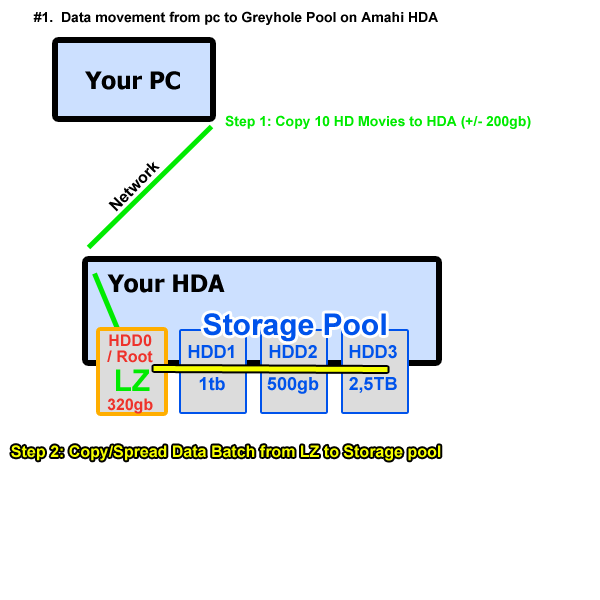Greyhole landing zone
Important things you have to know about the “LZ” (Greyhole Landing Zone)
When you are going to use Greyhole as a disk-pooling service, you have to keep a few important things in mind. Standard in the Fedora/Amahi install guide there is a small partition for “/”
(root aka System) like 20GB, recommendation for this size is bigger, but depends on the file batch size that is common for you to copy or move at the same time to you HDA-Pool (greyhole)
All data you copy to your HDA will first “Land” into your LZ (Greyhole Landing Zone) witch is located on “/” (root / System partition/drive) as default setting. From there on it will be spread out over you “Pool” shown as the example:
Basically to avoid problems in the future and keep it simple, there are two things to configure:
1. Make your “/” (System Partition / Drive) as big as the largest chunk of data that you copy/move to your HDA at a regular base. 2. Don’t include your “/” (Root /System Partition/ Drive) into you Greyhole Pool!!!
How does it Work
When you start the copy/move process from a client device (pc, laptop or such) Samba and Greyhole welcomes your data into the storage pool.
From there Greyhole looks where it has to go (disks with space) and how many copy's it should make of the data (preferences from the HDA Dashboard) if your que is empty (watch Greyhole commands how to see) it immateriality starts to copy the data out of you LZ to its final destination, if not it will be at the back of the existing que.
Meanwhile it is still receiving your data in the LZ and filling up the que with final destinations and number of copy's. This means that it does 2 things on one disk at once : 1. writing data into the LZ, 2. moving data to it's final destination on the disks present in your pool witch contains enough space. All of the locations are being stored in a SQL database witch Samba uses to locate your data when u request it.
Of course there are more options for configuring your LZ, more details about this you can find here: -LINK- but is recommend for experienced users.

